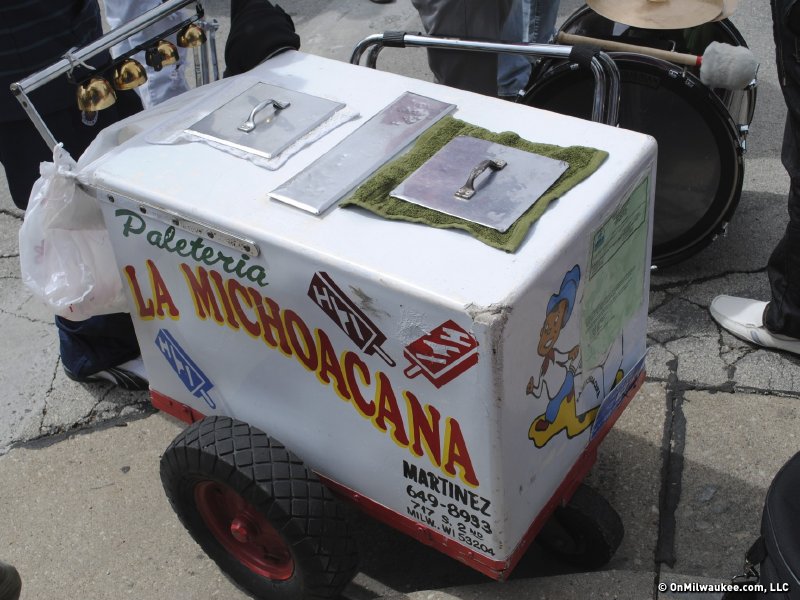Antonino Ramirez works a bicycle-driven cart containing paletas (pronounced pah-leh-tas), the increasingly popular fruit-based frozen treats that were first made in Mexico.
Ramirez is a paletero, the name for anyone who works a paletería which, like his cart, is the name for any place paletas are sold and paletero designates all the vendors who sell these fruity snacks-on-sticks.
Ramirez says he doesn't eat the paletas himself, at least the ones in his own cart, as that would cut into his profits. He sells paletas on commission, splitting the earnings 50 / 50 with his employer.
La Michoacana, 717 S. 2nd St., makes the paletas and owns Ramirez's bicycle-powered cart. The business has 22 carts, about three with bikes.
Edgar Martinez owns La Michoacana with his brother. They've had similar businesses in Chicago, Texas and Colorado, where they have family. They started La Michoacana in Milwaukee in 2004.
All the frozen treats are made at the unassuming store / warehouse building on South 2nd Street, which is located in one of the busiest commercial strips in Walker's Point. It's on the same block as Cielito Lindo and the Milwaukee Gay Arts Center and a block south of the Milwaukee Brewing Company.
There are a few other paleta vendors in Milwaukee's Latin neighborhoods, such as El Chavo, 730 W. Mitchell St., and their paleteros sell from similar pushcarts with bells a-ringing.
Martinez's white carts are marked "Paletería La Michoacana." His paleteros are all over the South Side, up into Riverwest and points farther west, depending on territories they want to stake out and whether they have cars big enough to accommodate the carts.
Many paleteros walk or bike great distances. The next time you see one crossing the 16th Street or 27th Street viaducts, picture yourself traveling almost three miles just to get to that point, let alone the rest of the blocks to your actual destination, a child-filled neighborhood or an area with lots of workers on break.
Paleteros load up their carts at La Michoacana each time they take them out, removing frozen treats from rows of large freezers and placing them in stacks on a wooden carrier, which makes counting easier.
The carts are loaded with the different flavors of paletas that the paletero knows are more likely to sell in the area they're traveling to, as well as other treat varieties sold from the carts, such as bolis (Colombian-style ice treats sold in bags, like popsicles).
Paletas are made with fruit pulp in a wide variety of flavors: lime, tamarind, strawberry, kiwi, pineapple, watermelon, mamey and banana. These sell for $1.25 each.
Others are blends of fruit and sweetened milk or cream, such as strawberry / chocolate and vanilla / coconut, which sell for $1.50.
Fruit and ice cream cups and the bolis sell for $1.50 as well. Bolis come in six flavors, lime, bubblegum, strawberry fruit, strawberry milk (there's a difference), coconut milk and vanilla. There are numerous other flavors, like the popular mango con chile, which is frozen heat heaven, lemon, cookies and cream (with actual cookie bits) and bubblegum.
The chiles come in many other flavors as well, from lime and pineapple to watermelon and cantaloupe.
Ramirez says all the flavors are very popular in the near South Side neighborhoods he usually frequents. Martinez says the best sellers are lime and bubblegum.
"The kids really like bubblegum," Martinez says, almost apologetically. He acknowledges that these sugary delights are a bit different than his naturally flavored, all-fruit paletas.
The bubblegum is a blue color that doesn't appear anywhere else on Earth; its closest relative might be the blue part of a Bomb Pop, but as Ramirez concurs "little people like them" and there's often a large stock of that flavor in each paletero's cart.
La Michoacana starts production early in the morning. Martinez says his workers make about 5,000 paletas, bolis and popsicles in eight hours.
Depending entirely on the weather, La Michoacana usually opens in May and closes August or September.
Business has been challenging so far this year, Martinez says, and overall it's been really slow since 2009.
"There's a lot of competition. My supplies are getting more expensive," he says.
Ramirez sets his own hours, but works often. Talking to other paleteros, one gets the impression that they're happy with the money they're earning. Ramirez just seems to like being out and about.
Ramirez moved to Wisconsin in 1990 after living in Texas since the '70s, where he worked as a ranch hand for many years, in addition to a number of carpentry and industrial jobs. He worked on a farm for many years when he first moved to Wisconsin.
Ramirez doesn't like to stay home. If he's not pedaling his La Michoacana cart he'll ride his own bike down to the store / warehouse and talk with some of the other paleteros while enjoying a paleta.
Royal Brevväxling is a writer, educator and visual artist. As a photo essayist, he also likes to tell stories with pictures. In his writing, Royal focuses on the people who make Milwaukee an inviting, interesting and inspiring place to live.
Royal has taught courses in critical pedagogy, writing, rhetoric and cultural studies at several schools in Wisconsin and Minnesota. He is currently Adjunct Associate Professor of Humanities at Milwaukee Institute of Art and Design.
Royal lives in Walker’s Point with his family and uses the light of the Polish Moon to illuminate his way home.







